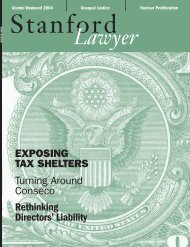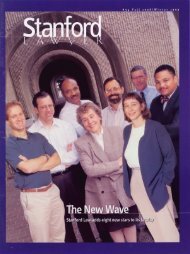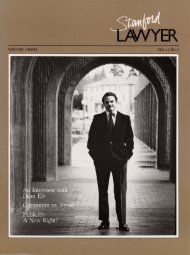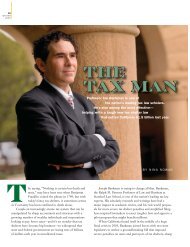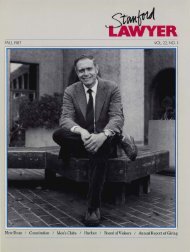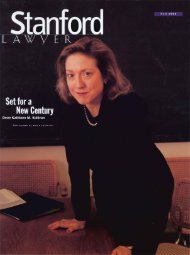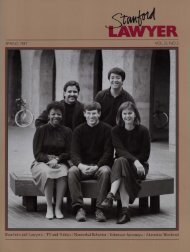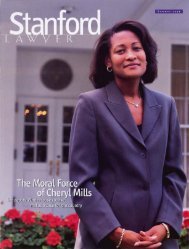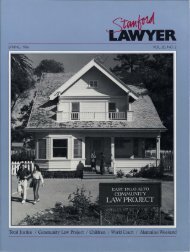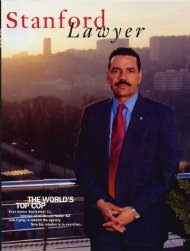Summer 2003 – Issue 66 - Stanford Lawyer - Stanford University
Summer 2003 – Issue 66 - Stanford Lawyer - Stanford University
Summer 2003 – Issue 66 - Stanford Lawyer - Stanford University
- No tags were found...
Create successful ePaper yourself
Turn your PDF publications into a flip-book with our unique Google optimized e-Paper software.
II19STANFORDLAWYERANITA PUT THE DIGITAL CODE INTO THE HTML OF HER SITE. THE DIGITALCODE DISPLAYS THE "SOME RIGHTS RESERVED" BUTTON ON HER SITEAND UNKS TO HER UCENSE.Cool! Now it'sreally clear howI want people touse my song.I www.anlta.comIGNACIO IS A FILM STUDENT IN SAN FRANCISCO. HE'S LOOKING FOR ASONG TO PUT IN HIS CLASS FILM PROJECT, SO HE SEARCHES FOR"NONCOMMERCIAL SONGS." THE SEARCH ENGINE FINDS THE DIGITALCODE ON ANITA'S SITE AND TELLS IGNACIO ALL ABOUT HER WORK.Creative Commons is not the only group developingsuch licenses. The Electrorric Frontier Foundation has onein place specifically for audio copying. A group at theMassachusetts Instimte of Technology has been experimentingwith its own version. Creative Commons, however, isprobably the biggest effort, having raised $2 million ingrants from the Center for the Public Domain and the JohnD. and Catherine T. MacArthur Foundation.So far, roughly one million works have been placed undera Creative Commons license, though the exact number is notImown. The group does not charge a fee to those who downloada license, nor does it keep a database of the visitors whohave done so. Lessig explains that Creative Commons wantsit to be easy for the average person to get and use a license."This has to be a lawyer-free zone," he says.In fact, getting a Creative Commons license is quick andpainless. Upon arriving at the site (www.creativecommons.org), one need only click on the "choose license" prompt,then answer a few yes-no questions: Do you want to requireattribution? Do you want to allow commercial uses of yourwork? Do you want to allow modifications of your work?And if you permit modifications, do you want to require thatthe modified work will be shared under the same rules asthis one? The visitor can then obtain a brief tag describingwhat conditions of reuse he is permitting, along with a linkto a more detailed version of the license on the CreativeCommons website. (There's an alternative label for hardcopyworks.)The concept is being put into practice by some notableartists and intellecmals. Roger McGuinn, a founder of therock band The Byrds, has used a Creative Commons licenseto permit noncommercial copying of several hundred folksongs that he has performed and placed on the L1ternet asMP3 files. Jerry Goldman, a political science professor atorthwestern <strong>University</strong> who founded the Oyez Project,which maintains an archive of recordings of Supreme Courthearings, in June placed several hundred hours of HighCourt arguments online, using a Creative Commons licenseto signal that they are available for copying.But equally important, the licenses are being embracedby artists and musicians who have yet to achieve notoriety.Colin Mutchler, a guitarist, wrote to Creative Commons inJuly that he had submitted a guitar track, titled "My Life,"to an online sound pool, Opsound, with a CreativeCommons license that permitted it to be reused and transformed,as long as the work was attributed to him and it wasfor a noncommercial use. One month after the track hadbeen posted, he received an e-mail from a 17 -year-old violinist,Cora Beth, who had added a violin track to his guitar.She called the new version, "My Life Changed.""I think the track is definitely more beautiful," Mutchlerwrote. "Maybe eventually we'll add drums and words."Lessig predicts that by the end of the year more than 10million works will be under Creative Commons licenses.That's an insignificant number viewed in the context of thebillions of works under traditional copyright, but Lessig saysit will demonstrate mass support that will encourageCongress to change existing copyright law. He is championinga bill, the Public Domain Enhancement Act, thatwould require copyright holders to register their works after50 years if they want them to be protected for the remainingyears of the term. All works that are not registered wouldenter the public domain.The idea that a grassroots movement is building overcopyright may sound odd. As many law school graduates willattest, copyright isn't exactly the most glamorous subject inthe curriculum. In writings and lectures, however, Lessigpresents the issue as one that cuts to the heart of sustainingfree expression and a free culmre in the 21st cenmry. While





